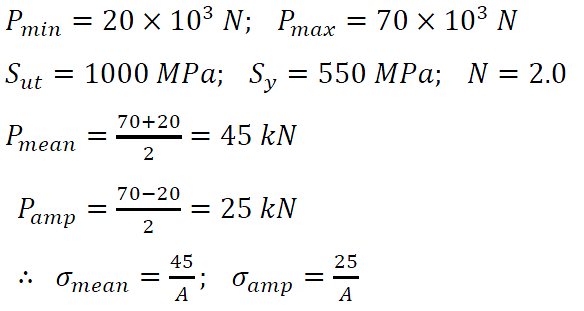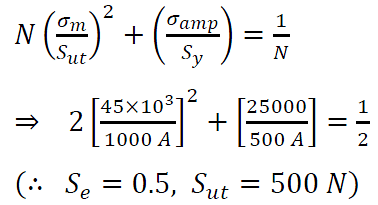Mechanical Engineering Exam > Mechanical Engineering Questions > A rod of circular cross section is subjected...
Start Learning for Free
A rod of circular cross section is subjected to an alternating tensile force, varying from 20 kN to 70 kN S„ = 1000 MPa; Sy = 550 MPa; FOS = 2.0 Neglect stress concentration effect and other correction factors The diameter of the rod according to Gerber's theory (in mm) is
- a)8
- b)10
- c)12
- d)15
Correct answer is option 'D'. Can you explain this answer?
| FREE This question is part of | Download PDF Attempt this Test |
Most Upvoted Answer
A rod of circular cross section is subjected to an alternating tensil...
Tensile Force and Stress
The rod is subjected to an alternating tensile force, varying from 20 kN to 70 kN. The force applied to the rod causes stress in the material. Stress is defined as the force applied per unit area.
Stress Limitations
The material of the rod has two stress limitations: the ultimate tensile stress (Su) and the yield stress (Sy). The ultimate tensile stress is the maximum stress that the material can withstand before failure. The yield stress is the stress at which the material starts to deform permanently.
Gerber's Theory
Gerber's theory is used to calculate the diameter of the rod based on the alternating tensile force and the stress limitations of the material. According to Gerber's theory, the diameter (d) can be determined using the following equation:
d = (16Fa/π(Su-Sy))^(1/3)
where Fa is the alternating force, Su is the ultimate tensile stress, and Sy is the yield stress.
Calculation
In this case, the alternating tensile force (Fa) is given as 70 kN - 20 kN = 50 kN. The ultimate tensile stress (Su) is given as 1000 MPa, and the yield stress (Sy) is given as 550 MPa. The factor of safety (FOS) is given as 2.0.
Substituting these values into the equation, we get:
d = (16 * 50 * 10^3 / π * (1000 - 550))^(1/3)
= (80000000 / 450π)^(1/3)
≈ 14.495 mm
Since the diameter of the rod according to Gerber's theory is approximately 14.495 mm, the correct answer is option 'D' (15 mm).
Free Test
FREE
| Start Free Test |
Community Answer
A rod of circular cross section is subjected to an alternating tensil...

Using Gerber’s Theory



Attention Mechanical Engineering Students!
To make sure you are not studying endlessly, EduRev has designed Mechanical Engineering study material, with Structured Courses, Videos, & Test Series. Plus get personalized analysis, doubt solving and improvement plans to achieve a great score in Mechanical Engineering.

|
Explore Courses for Mechanical Engineering exam
|

|
Similar Mechanical Engineering Doubts
A rod of circular cross section is subjected to an alternating tensile force, varying from 20 kN to 70 kN S„ = 1000 MPa; Sy = 550 MPa; FOS = 2.0 Neglect stress concentration effect and other correction factors The diameter of the rod according to Gerber's theory (in mm) isa)8b)10c)12d)15Correct answer is option 'D'. Can you explain this answer?
Question Description
A rod of circular cross section is subjected to an alternating tensile force, varying from 20 kN to 70 kN S„ = 1000 MPa; Sy = 550 MPa; FOS = 2.0 Neglect stress concentration effect and other correction factors The diameter of the rod according to Gerber's theory (in mm) isa)8b)10c)12d)15Correct answer is option 'D'. Can you explain this answer? for Mechanical Engineering 2024 is part of Mechanical Engineering preparation. The Question and answers have been prepared according to the Mechanical Engineering exam syllabus. Information about A rod of circular cross section is subjected to an alternating tensile force, varying from 20 kN to 70 kN S„ = 1000 MPa; Sy = 550 MPa; FOS = 2.0 Neglect stress concentration effect and other correction factors The diameter of the rod according to Gerber's theory (in mm) isa)8b)10c)12d)15Correct answer is option 'D'. Can you explain this answer? covers all topics & solutions for Mechanical Engineering 2024 Exam. Find important definitions, questions, meanings, examples, exercises and tests below for A rod of circular cross section is subjected to an alternating tensile force, varying from 20 kN to 70 kN S„ = 1000 MPa; Sy = 550 MPa; FOS = 2.0 Neglect stress concentration effect and other correction factors The diameter of the rod according to Gerber's theory (in mm) isa)8b)10c)12d)15Correct answer is option 'D'. Can you explain this answer?.
A rod of circular cross section is subjected to an alternating tensile force, varying from 20 kN to 70 kN S„ = 1000 MPa; Sy = 550 MPa; FOS = 2.0 Neglect stress concentration effect and other correction factors The diameter of the rod according to Gerber's theory (in mm) isa)8b)10c)12d)15Correct answer is option 'D'. Can you explain this answer? for Mechanical Engineering 2024 is part of Mechanical Engineering preparation. The Question and answers have been prepared according to the Mechanical Engineering exam syllabus. Information about A rod of circular cross section is subjected to an alternating tensile force, varying from 20 kN to 70 kN S„ = 1000 MPa; Sy = 550 MPa; FOS = 2.0 Neglect stress concentration effect and other correction factors The diameter of the rod according to Gerber's theory (in mm) isa)8b)10c)12d)15Correct answer is option 'D'. Can you explain this answer? covers all topics & solutions for Mechanical Engineering 2024 Exam. Find important definitions, questions, meanings, examples, exercises and tests below for A rod of circular cross section is subjected to an alternating tensile force, varying from 20 kN to 70 kN S„ = 1000 MPa; Sy = 550 MPa; FOS = 2.0 Neglect stress concentration effect and other correction factors The diameter of the rod according to Gerber's theory (in mm) isa)8b)10c)12d)15Correct answer is option 'D'. Can you explain this answer?.
Solutions for A rod of circular cross section is subjected to an alternating tensile force, varying from 20 kN to 70 kN S„ = 1000 MPa; Sy = 550 MPa; FOS = 2.0 Neglect stress concentration effect and other correction factors The diameter of the rod according to Gerber's theory (in mm) isa)8b)10c)12d)15Correct answer is option 'D'. Can you explain this answer? in English & in Hindi are available as part of our courses for Mechanical Engineering.
Download more important topics, notes, lectures and mock test series for Mechanical Engineering Exam by signing up for free.
Here you can find the meaning of A rod of circular cross section is subjected to an alternating tensile force, varying from 20 kN to 70 kN S„ = 1000 MPa; Sy = 550 MPa; FOS = 2.0 Neglect stress concentration effect and other correction factors The diameter of the rod according to Gerber's theory (in mm) isa)8b)10c)12d)15Correct answer is option 'D'. Can you explain this answer? defined & explained in the simplest way possible. Besides giving the explanation of
A rod of circular cross section is subjected to an alternating tensile force, varying from 20 kN to 70 kN S„ = 1000 MPa; Sy = 550 MPa; FOS = 2.0 Neglect stress concentration effect and other correction factors The diameter of the rod according to Gerber's theory (in mm) isa)8b)10c)12d)15Correct answer is option 'D'. Can you explain this answer?, a detailed solution for A rod of circular cross section is subjected to an alternating tensile force, varying from 20 kN to 70 kN S„ = 1000 MPa; Sy = 550 MPa; FOS = 2.0 Neglect stress concentration effect and other correction factors The diameter of the rod according to Gerber's theory (in mm) isa)8b)10c)12d)15Correct answer is option 'D'. Can you explain this answer? has been provided alongside types of A rod of circular cross section is subjected to an alternating tensile force, varying from 20 kN to 70 kN S„ = 1000 MPa; Sy = 550 MPa; FOS = 2.0 Neglect stress concentration effect and other correction factors The diameter of the rod according to Gerber's theory (in mm) isa)8b)10c)12d)15Correct answer is option 'D'. Can you explain this answer? theory, EduRev gives you an
ample number of questions to practice A rod of circular cross section is subjected to an alternating tensile force, varying from 20 kN to 70 kN S„ = 1000 MPa; Sy = 550 MPa; FOS = 2.0 Neglect stress concentration effect and other correction factors The diameter of the rod according to Gerber's theory (in mm) isa)8b)10c)12d)15Correct answer is option 'D'. Can you explain this answer? tests, examples and also practice Mechanical Engineering tests.

|
Explore Courses for Mechanical Engineering exam
|

|
Suggested Free Tests
Signup for Free!
Signup to see your scores go up within 7 days! Learn & Practice with 1000+ FREE Notes, Videos & Tests.
























